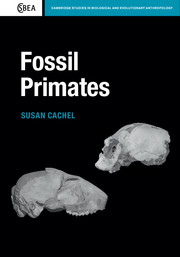Book contents
- Frontmatter
- Dedication
- Contents
- Acknowledgments
- Preface
- 1 Introduction: primates in evolutionary time
- 2 Primate taxonomy
- 3 Fossils and fossilization
- 4 The world of the past
- 5 The lifeways of extinct animals
- 6 Evolutionary processes and the pattern of primate evolution
- 7 Primate origins
- 8 The Paleocene primate radiation
- 9 The Eocene primate radiation
- 10 The Malagasy primate radiation
- 11 The Oligocene bottleneck
- 12 Rise of the anthropoids
- 13 The platyrrhine radiation
- 14 The Miocene hominoid radiation
- 15 The cercopithecoid radiation
- 16 Late Cenozoic climate changes
- 17 Conclusions
- References
- Index
10 - The Malagasy primate radiation
Published online by Cambridge University Press: 05 April 2015
- Frontmatter
- Dedication
- Contents
- Acknowledgments
- Preface
- 1 Introduction: primates in evolutionary time
- 2 Primate taxonomy
- 3 Fossils and fossilization
- 4 The world of the past
- 5 The lifeways of extinct animals
- 6 Evolutionary processes and the pattern of primate evolution
- 7 Primate origins
- 8 The Paleocene primate radiation
- 9 The Eocene primate radiation
- 10 The Malagasy primate radiation
- 11 The Oligocene bottleneck
- 12 Rise of the anthropoids
- 13 The platyrrhine radiation
- 14 The Miocene hominoid radiation
- 15 The cercopithecoid radiation
- 16 Late Cenozoic climate changes
- 17 Conclusions
- References
- Index
Summary
Lost Lemuria
In 1864, the English zoologist Philip Lutley Sclater published a paper called “The Mammals of Madagascar.” In this paper, he proposed that a mighty continent occupying most of the Pacific and Indian Oceans had once connected South America, Africa, and India in the southern hemisphere. This was approximately 100 years before the universal acceptance of plate tectonic theory. The present geography of the world was thought to have been in existence since the origin of continents and oceans, and only the rise and fall of mountain chains and sea levels could affect the surface of the earth. Given the view that geography had been static throughout earth history, the distribution of living and fossil organisms was sometimes a mystery to biologists. They often invoked the rapid appearance and disappearance of land bridges to account for otherwise inexplicable distributions. Given this mindset, Sclater argued for a previously unknown land connection on a grand scale—in fact, he argued for the existence of an unknown giant continent. Because he thought that this continent accounted for the distribution of lemurs and other prosimian primates, he named it “Lemuria.” Similarities between South American and African monkeys were also explained by this land bridge connection. Sclater also noted the peculiar nature of the animals and plants of Madagascar—many species were endemic to Madagascar—and the sharp rift between African and Malagasy species even though Madagascar lies off the coast of Africa. He argued that the homeland of the prosimian primates would appear to be Madagascar, given their modern distribution. He believed that prosimians were different enough from anthropoid primates to be put in a different order of mammals, although he retained the traditional zoological classification that sorted prosimians and anthropoids together in the Order Primates (Sclater & Sclater, 1899). Yet, Sclater considered the prosimians to be very ancient, and argued that their original homeland, in remote geological time, had once been the now lost continent of Lemuria.
- Type
- Chapter
- Information
- Fossil Primates , pp. 155 - 173Publisher: Cambridge University PressPrint publication year: 2015



